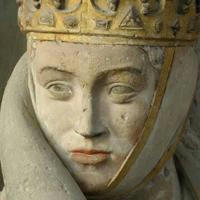
The Exaltation of Beauty
European art and culture. @Revolt888 @WrathOfGnon77 @OrthodoxSpirituality555
Show more6 267
Subscribers
+324 hours
-67 days
-130 days
- Subscribers
- Post coverage
- ER - engagement ratio
Data loading in progress...
Subscriber growth rate
Data loading in progress...
So Cabaillot-Lassalle achieved a real tour de force with this canvas, by including six miniatures created by other painters on it. It’s likely that these colleagues of his, four of whom lived close to the artist, on or near Boulevard de Clichy, each came to his studio to create their little paintings on clearly predetermined spaces on the canvas. Cabaillot-Lassalle then probably added the frames around the miniatures, and finally the figures in the foreground, four of whom overlap the reductions. You can see clear differences of workmanship from one miniature to the next, and all of them differ from Cabaillot-Lassalle’s dry, precise style.
RF MO P 2023 2 - 20230304.jpg4.03 KB
Photo unavailableShow in Telegram
Camille Cabaillot-Lassalle, The Salon of 1874, oil on canvas, 100 × 85 cm, Musée d'Orsay
The painting depicts an appealing genre scene. It immerses us in one of the 1874 Salon’s galleries, which is thronged with visitors: two elegant young women accompanied by a little girl; an older woman consulting the Salon catalogue; three men contemplating the paintings hung close together on the picture rail in front of them.
The painter didn’t transcribe a scene he’d observed, but rather anticipated it; by doing so, he painted an altogether unique work, with no equivalent elsewhere. The paintings depicted on the wall reproduce works that were actually exhibited at the 1874 Salon: a still life by Eugène Petit, landscapes by Jules Jacques Veyrassat, Ernest Guillemer, Camille Corot and Léon Richet, and a portrait by Henriette Browne. The Salon catalogue points this out, and what’s more, states that “the reductions of paintings features on this canvas were painted by the authors of the originals”.
Photo unavailableShow in Telegram
The Sculpture Show, Paris Salon, 1879, by Camille-Leopold Cabaillot Lassalle, private collection
Cenni di Francesco di Ser Cenni used lavish amounts of gold leaf and different types of punch marks and tooling to describe the haloes and sumptuous fabrics. He took great pains to include details such as attributes for saints on the side wings and landscapes in most of the predella panels. Placed on an altar, the opulence of this altarpiece inspired awe in fourteenth-century Christian worshippers and offered an elaborate backdrop during the celebration of Mass.
08d7d311-d4c1-4fa7-8b2e-d2a198369951_2328.jpg1.76 MB
Photo unavailableShow in Telegram
Polyptych with Coronation of the Virgin and Saints, about 1390s, by Cenni di Francesco di Ser Cenni, tempera and gold leaf on panel, 355.6 × 239.1 cm, Getty Museum
In the central panel of this opulent polyptych, Christ crowns his mother, the Virgin Mary, as gathered angels and saints look on. The altarpiece stood in a chapel dedicated to Saint Benedict in the Church of Santa Trinità, Florence.
The altarpiece's various panels do not depict episodes in chronological order. In the pinnacles above the central scene, which were added at a later date, the archangel Gabriel announces the conception of Christ to the Virgin. Below, in the predella, the row of scenes in the lowest register, the Virgin's death is represented at the center. On the far left, Saint Benedict exorcises a devil, and in the panel alongside Saint John baptizes Christ. To the right of the Virgin's death, devils torment Saint Anthony, while on the far right Saint Lawrence liberates a soul from purgatory.
As part of the campaign to save the sculpted masterpieces in the gardens of Louis XIV, the marble originals from the Garden of Versailles were added to the collection. Working in conjunction with the Louvre Museum, the Palace of Versailles is keen to continue its policy of showcasing spaces and collections and is making every effort to provide public access to these remarkable works.
This collection of mouldings based on works from Antiquity is known for its ancient 17th and 18th century mouldings and a fine collection of Greek and Roman architecture. The most precious jewels among these copies include those of the corner of the Parthenon from the Acropolis in Athens, one of the Quirinal Dioscures in Rome, and the Farnese Hercules, the original of which is now preserved in the archaeological museum of Naples.
Choose a Different Plan
Your current plan allows analytics for only 5 channels. To get more, please choose a different plan.
